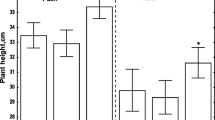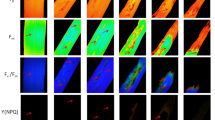Abstract
We investigated the effect of treating soft wheat seeds (Triticum aestivum L.) with two Pseudomonas bacteria strains, isolated from earthworm coprolites, showing a significant antifungal and growth-promoting action in preliminary screening on the activity of guaiacol-dependant peroxidase under phytopathogenic load in the presence of Bipolaris sorokiniana (Sacc.) Shoemaker as a mechanism for inducing plant resistance to the pathogen. We established a statistically significant decrease (P < 0.05) in root rot disease incidence and severity during bacterization, which is indicative both of antifungal activity of the used bacterial isolates and of their successful colonizing the rhizosphere of wheat plants. We noted a response of free and weakly bound peroxidase of wheat plants to infection with B. sorokiniana: the enzyme activity increased during pathogenesis. Bacterization also increased peroxidase activity in plant leaves and roots, the greatest differences from non-bacterized plants being observed in wheat roots in the presence of the pathogen. We detected a direct link between peroxidase activity in wheat roots and leaf tissues in the absence of the pathogen and the feedback between peroxidase activity and plant infestation by the root rot pathogen. In the presence of the phytopathogen, there is a lack of correlation between peroxidase activity in wheat roots and leaves, and there is a shift of activity towards its increase in roots, which plays an important role in the development of systemic resistance against the root rot pathogen that penetrates into plants through the roots and root collar.
Similar content being viewed by others
References
Plotnikova, L.Y., The involvement of reactive oxygen species in defense of wheat lines with the genes introgressed from Agropyron species contributing the resistance against brown rust, Russ. J. Plant Physiol., 2009, vol. 56, pp. 181–189.
García-Cristobal, J., García-Villaraco, A., Ramos, B., Gutierrez-Mañero, J., and Lucas, J.A., Priming of pathogenesis related-proteins and enzymes related to oxidative stress by plant growth promoting rhizobacteria on rice plants upon abiotic and biotic stress challenge, J. Plant Physiol., 2015, vol. 188, pp. 72–79.
Perfil'eva, A.I., Rymareva, E.V., Rikhvanov, E.G., Zhivetev, M.A., and Graskova, I.A., The activity of peroxidase in phytopathological system ring root—vegetative organs of potato plants on iodoacetic acid sodium salt and heating, Agrokhimiya, 2015, pp. 63–70.
Maksimov, I.V., Valeev, A.Sh., Cherepanova, E.A., and Yarullina, L.G., Hydrogen peroxide production in wheat leaves infected with the fungus Septoria nodorum Berk. strains with different virulence, Appl. Biochem. Microbiol., 2009, vol. 45, pp. 481–486.
Yarullina, L.G., Kasimova, R.I., and Akhatova, A.R., Comparison of the transcriptional activity of protective protein genes in different wheat cultivars infected with Septoria nodorum Berk., Appl. Biochem. Microbiol., 2014, vol. 50, pp. 599–603.
Manikandan, R. and Raguchander, T., Fusarium oxysporum f. sp. lycopersici retardation through induction of defensive response in tomato plants using a liquid formulation of Pseudomonas fluorescens (Pf1), Eur. J. Plant Pathol., 2014, vol. 140, pp. 469–480.
Choudhary, D.K., Kasotia, A., Jain, S., Vaishnav, A., Kumari, S., Sharma, K.P., and Varma, A., Bacterial-mediated tolerance and resistance to plants under abiotic and biotic stresses, J. Plant Growth Regul., 2016, vol. 35, pp. 276–300.
Graskova, I.A., Borovskii, G.B., Kolesnichenko, A.V., and Voinikov, V.K., Peroxidase as a component of the signaling pathway in potato cells during ring rot infection, Russ. J. Plant Physiol., 2004, vol. 51, pp. 621–626.
Maksimov, I.V., Abizgil’dina, R.R., and Pusenkova, L.I., Plant growth promoting rhizobacteria as alternative to chemical crop protectors from pathogens (review), Appl. Biochem. Microbiol., 2011, vol. 47, pp. 333–345.
Semenova, E.A., Dubovitskaya, L.K., and Titova, S.A., Evaluation of stability of Glycine max (L.) Merril to root rot in enzymatic activity, Russ. J. Agric. Sci., 2014, no. 2, pp. 18–20
Van Loon, L.C., Plant responses to plant growth-promoting rhizobacteria, Eur. J. Plant Pathol., 2007, vol. 119, pp. 243–254.
Hol, W.H., Bezemer, T.M., and Biere, A., Getting the ecology into interactions between plants and the plant growth-promoting bacterium Pseudomonas fluorescens, Front. Plant Sci., 2013, vol. 4: 81. doi 10.3389/fpls.2013.00081
Jankiewicz, U. and Kotonowicz, M., The involvement of Pseudomonas bacteria in induced systemic resistance in plants (review), Appl. Biochem. Microbiol., 2012, vol. 48, pp. 276–281.
Pieterse, C.M.J., Zamioudis, C., Berendsen, R.L., Weller, D.M., van Wees, S.C.M., and Bakker, P.A.H.M., Induced systemic resistance by beneficial microbes, Annu. Rev. Phytopathol., 2014, vol. 52, pp. 347–375.
Jain, A. and Das, S., Insight into the interaction between plants and associated fluorescent Pseudomonas spp., Int. J. Agron., 2016, vol. 2016: 4269010. doi 10.1155/2016/4269010
Maksimov, I.V., Veselova, S.V., Nuzhnaya, T.V., Sarvarova, E.R., and Khairullin, R.M., Plant growth promoting bacteria in regulation of plant resistance to stress factors, Russ. J. Plant Physiol., 2015, vol. 62, pp. 715–726.
Minaeva, O.M. and Akimova, E.E., Effectiveness of applying bacteria Pseudomonas sp., strain B-6798, for anti-phytopathogenic protection of crops in Western Siberia, Vestn. Tomsk Gos. Univ., Biol., 2013, no. 3, pp. 19–37 https://doi.org/vital.lib.tsu.ru/vital/access/manager/Repository/vtls:000466720
Tereshchenko, N.N., Kravets, A.V., Akimova, E.E., Minayeva, O.M., and Zotikova, A.P., Effectiveness of applying microorganisms isolated from earthworm coprolites in increasing yielding capacity of grain crops, Sib. Herald Agric. Sci., 2013, pp. 10–17.
Baslavskaya, S.S. and Trubetskova, O.M., Praktikum po fiziologii rasteniy (Practical Works on Plant Physiology), Moscow: Izd. Mosk. Gos. Univ., 1964.
Cooke, B.M., Disease assessment and yield loss, in The Epidemiology of Plant Diseases, Cooke, B.M., Jone, D.G., and Kaye, B., Eds., Dordrecht: Springer, 2006, pp. 43–80.
Boyarkin, A.N., Rapid method for peroxidase activity determination, Biokhimiya, 1951, vol. 16, pp. 352–355.
Yang, J., Kloepper, J.W., and Ryu, Ch.M., Rhizosphere bacteria help plants tolerate abiotic stress, Trends Plant Sci., 2009, vol. 14, pp. 1–4.
Beneduzi, A., Ambrosini, A., and Passaglia, L.M.P., Plant growth-promoting rhizobacteria (PGPR): their potential as antagonists and biocontrol agents, Genet. Mol. Biol., 2012, vol. 35, pp. 1044–1051.
Minaeva, O.M., Apenysheva, M.V., Akimova, E.E., Blinova, P.A., and Kurowski, A.V., Influence of wheat seed inoculation on oxidase activity in plants under phytopathogenic load, Dostizheniya Nauki i Tekhniki APK, 2015, vol. 29, pp. 53–56.
Maksimov, I.V., Abizgil’dina, R.R., Yusupova, Z.R., and Khairullin, R.M., Effect of bacteria B. subtilis 26D on the content of hydrogen peroxide and peroxidase activity in winter wheat, Agrokhimiya, 2010, pp. 55–60.
Van Lelyveld, L.J. and van Vuuren, S.P., Peroxidase activity as a marker in greening disease of citrus for assessment of tolerance and susceptibility, J. Phytopathol., 1988, vol. 121, pp. 357–362.
Reuveni, R., Biochemical markers for disease resistance, in Molecular Methods in Plant Pathology, Singh, R.P. and Singh, U.S., Eds., Boca Raton: CRC, 1995, pp. 99–114.
Author information
Authors and Affiliations
Corresponding author
Additional information
Published in Russian in Fiziologiya Rastenii, 2018, Vol. 65, No. 5, pp. 366–375.
The article was translated by authors.
Rights and permissions
About this article
Cite this article
Minaeva, O.M., Akimova, E.E., Tereshchenko, N.N. et al. Effect of Pseudomonas Bacteria on Peroxidase Activity in Wheat Plants when Infected with Bipolaris sorokiniana. Russ J Plant Physiol 65, 717–725 (2018). https://doi.org/10.1134/S1021443718040052
Received:
Published:
Issue Date:
DOI: https://doi.org/10.1134/S1021443718040052




